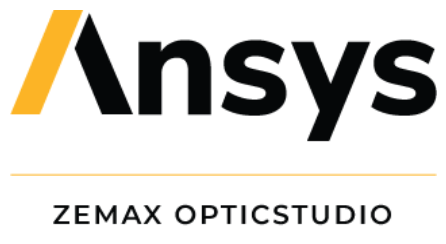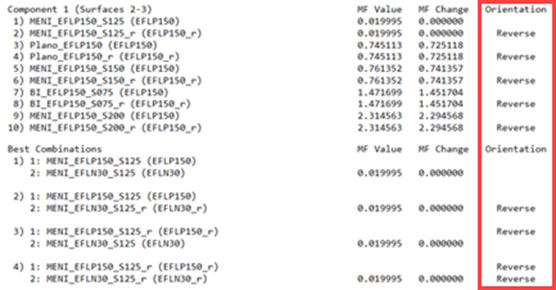
August 2nd, 2023
1 Tools, Features, and Capabilities
1.1 Stock lens Matching Tool Improvements (All Editions)
Test a wider range of catalog lenses for more options for lens matching and optimization.
The Stock Lens Matching tool will now test the orientation of stock lenses in both directions when determining the best match between lenses provided by optical vendors in our stock catalog to the lens data in your OpticStudio design.
In addition to filtering stock lenses based on effective focal length (EFL) and entrance pupil diameter (EPD), the tool now filters stock lenses based on their shape factor. If the product of the designed lens shape and the stock lens shape is negative, that means the two shape factors have a different sign, and the stock lens will be flipped before further considering it for substitution in the design. If the designed lens shape factor is zero, or if the product of the designed lens shape and the stock lens shape is positive, the tool will not flip the stock lens.
The final report states the orientation of the matched stock lenses.

1.2 Reduced Restrictions on Surfaces Following GRINs (All Editions)
New surfaces are now allowed to follow GRIN surfaces.
Designs that utilize GRIN surfaces in sequential mode can now have new surfaces follow them in the Lens Data Editor. This enables a broad range of new possibilities for designs that feature aspheric surfaces and GRINs such as consumer electronic devices. This change is applicable for all GRIN surface types including STAR Thermal GRINs.
Surfaces that are now supported:
- Extended Asphere
- Extended Odd Asphere
- Q-Type Asphere
- Zernike Standard Sag
- Zernike Fringe Sag
2 Libraries and Catalogs
2.1 Catalog Updates (All Editions)
Get the latest material catalogs from Arton, Sumita, and TEIJIN
Materials:
- The Arton material catalog has been updated:
- Added 2 new materials: D4000 and F3500. D4000 is an improved version of the existing F5023 material, and F3500 is an improved version of F4520.
- Status of all materials except D4000 and F3500 was set to obsolete.
- The Sumita material catalog has been updated:
- Added 9 new materials: K-PBK60, K-LaSFn8W, K-SFLD8W, K-CSK158, K-PMK155, K-PSFn185, K-SKLD300, K-SKLD5, K-VC174.
- Several glass materials were updated. Internal transmittance of K-LaSFn17 was updated. General specifications of K-SFLDn3 were updated. Internal transmittances defined with 3mm and 10mm thickness were updated.
- Status of K-CaFK95, K-PMK30, K-PSK100, K-PSK200, K-SKLD200, K-LaFK50, K-LaFK55, K-VC78, K-VC90, K-VC91, K-VC99, K-VC100, K-VC181, K-CD45, K-CD120, K-ZnSF8, K-PSFn3, K-PSFn190, K-PG325, K-PG375, K-FK5, K-BK7, K-SK16RH, K-SK18RH, K-LaK10, K-LaK12, K-LaK18, K-LaSFn1, K-LaSFn2, K-LaSFn3, K-LaSFn17, K-LaSFn22, K-BOC30, K-GIR140, and K-FIR98UV was updated.
- The TEIJIN material catalog has been added:
- New catalog with 4 materials: AD-5503, SP-1516, SP-3810, SP-5590.
- TEIJIN’s "SP" series are special polycarbonate resins for optical use. Due to high refractive index and low birefringence, these materials are suitable for making camera lenses smaller, thinner, and with higher performance. They also have a high heat resistance and are suitable for applications that require long-term reliability.
3 Bug Fixes
- Afocal Mode - Fixed an issue where the afocal units from the System Explorer were not correctly reflected in the following sequential analyses: Through Focus Spot Diagram, Matrix Spot Diagram, Full Field Spot Diagram, and Configuration Matrix Spot Diagram.
- Scattering - For scattering in non-sequential mode with both transmission and reflection .BSDF files specified for each surface, a restriction was removed that had limited the sum of both transmitted and reflected total integrated scatter to a total of 1.0. This restriction could have caused some cases to have improperly allocated power for split rays.
- Toroidal Surface - Fixed an issue with calculating ray intercepts for Toroidal Surfaces in sequential mode that could cause discontinuous ray trace results in some cases.
- ZOS-API - Fixed issue where non-sequential ray tracing using batch ray tracing in the ZOS-API could not be forced to use a single core.



